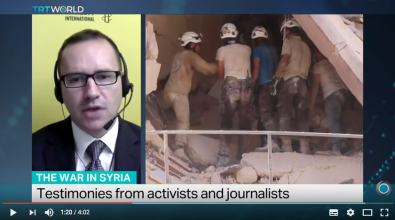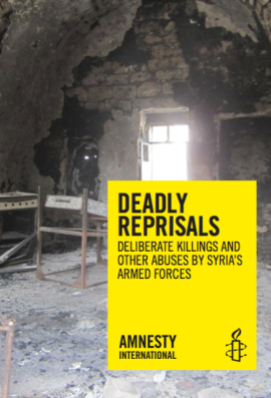Feb 27
20190
Amnesty International, Imperialist Wars/Occupations, The International Campaign to Destabilize Venezuela
Playing Politics With Human Rights – How Amnesty International Distorted the Facts on Nicaragua
DISMISSING THE TRUTH
Why Amnesty International is wrong about Nicaragua – An evaluation and response to the Amnesty International report ‘Instilling Terror: from lethal force to persecution in Nicaragua’
Published February 2019
Foreword
By Camilo Mejia, former Amnesty International Prisoner of Conscience
‘In war, truth is the first casualty.’ (Aeschylus)
The above quote, attributed to the ancient Greek tragedian Aeschylus, is timely and relevant to the Nicaraguan crisis more than 2500 years after its writing, not only because what has been happening in Nicaragua since April of last year is nothing shy of a war – military, economic, psychological,cultural, political – but also because the truth about the crisis, with the full support of Amnesty International, was indeed the first casualty.
Throughout this critique of Amnesty International’s coverage and reporting of the crisis in Nicaragua, readers will find how public opinion has been manipulated in order to present a highly biased, antigovernment account of the violent events that befell the Central American nation between April and September of 2018. For starters, the first three people who died were a Sandinista, a police officer, and an innocent bystander returning home from work, and their deaths were not only violent, they marked the beginning of a pattern of death and destruction carried out by the opposition that was completely ignored by AI’s two reports: Shoot to Kill and Instilling Terror.
Secretary General of Amnesty International, Kumi Naidoo
Equally damaging to AI’s omission of the killing of Sandinistas, and anyone standing up to the opposition, is its insistence in portraying the anti-government protesters as peaceful, despite overwhelming photographic and video evidence to the contrary. Along with the misleading portrayal
of protesters as unarmed and peaceful, Amnesty also insists on painting the different actions by the opposition as legitimate civic acts of protest, when in reality they were marred by violence and death, as is obvious from the evidence throughout the report which follows.
Some of the notable cases overlooked by AI include the kidnapping and attempted murder of student union leader Leonel Morales, who supported the initial marchers on behalf of his union but was nearly killed by the opposition after the government called for a national dialogue, prompting
Morales to call off the protests. Another case was that of Sander Bonilla, a member of the Sandinista Youth whose kidnapping and torture, overseen by both Catholic and Evangelical priests, were captured on video. There are many other cases, presented here, of victims of the opposition that
were either omitted or manipulated by Amnesty International in its two official reports.
Perhaps the most important benefit that this response provides its readers is the encouragement to verify much of the information countering AI’s claims. This response does not address the entirety of AI’s reports (and focuses on the second one), but it provides sufficient information for readers to gain access to enough facts to discover a much wider picture of the crisis, and that in itself is a huge achievement.
While it is of vital importance that people become aware of the reality that we can no longer trust prestigious human rights organizations to tell us what is happening in the world, the real triumph of this critique would be for readers to go beyond both the crisis in Nicaragua and the destabilizing role Amnesty has played in it, because the truth is not a casualty only in Nicaragua, but everywhere else as well. And the real tragedy is not that we may no longer trust AI or others to tell us the truth, but that we have ceded our own agency, our own ability to question dominant narratives, and have chosen instead to blindly trust what powerful entities tell us.
As I write this foreword the United States’ war drums beat on Venezuela, where Amnesty International has also played a very destabilizing role. And that is how the story goes: the United States chooses a government for regime change, calls upon its grantees – media outlets of global
reach, human rights organizations, diplomatic entities, other powerful nations – to vilify the chosen government; before we know, and without ever taking the time to vet the information, we fall prey to the media spell and begin to provide our consent for intervention.
Lives matter! All lives! – including the lives of those whose deaths were omitted by Amnesty International in its two reports on Nicaragua. The lives of those the anti-government opposition robbed, kidnapped, tortured, raped, killed, and even burned in public view, matter. So why not view
this critique of a highly reputable human rights organization as an invitation to question the dominant narratives that herald invasions and occupations? We must reclaim our ability, our moral duty, to search for the truth, to find it and uphold it, to protect it, and to hold everyone accountable to it, starting with ourselves.
This report, Dismissing the Truth, provides a way for readers to do precisely that: find the truth on their own.
Miami, Florida, February 2019
DOWNLOAD THE DISMISSING THE TRUTH REPORT: dismissing_truth










 As far as I can tell, the fresh evidence advertised in the report was gathered through conversations and tours Rovera had in those weeks.
As far as I can tell, the fresh evidence advertised in the report was gathered through conversations and tours Rovera had in those weeks.








